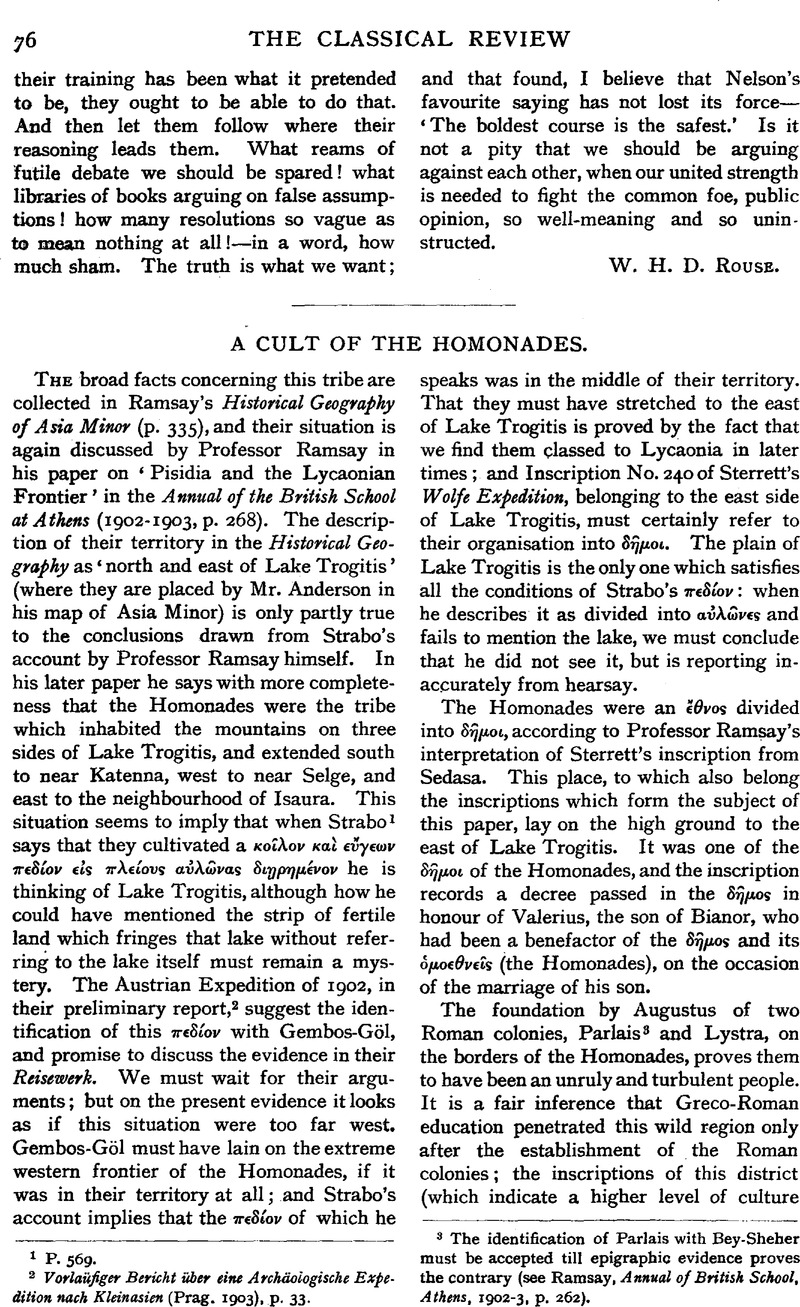Article contents
A Cult of the Homonades
Published online by Cambridge University Press: 27 October 2009
Abstract

- Type
- Original Contributions
- Information
- Copyright
- Copyright © The Classical Association 1910
References
page 76 note 1 P. 569.
page 76 note 2 Vorlaüfiger Bericht über eine Archäologische Expedition nach Kleinasien (Prag. 1903), p. 33Google Scholar.
page 76 note 3 The identification of Parlais with Bey-Sheher must be accepted till epigraphic evidence proves the contrary (see Ramsay, , Annual of British School, Athens, 1902–1903, p. 262)Google Scholar.
page 77 note 1 An art similar to that of Dorla (see Miss Ramsay in Studies in the … Eastern Roman Provinces) flourished in the entire mountain region north and east of Trogitis Lake.
page 77 note 2 Wolfe Expedition, p. 141. The presence of a priest of the Augusti shows that the temple of Zeus at Sedasa was the most important one in the region, and a dedication from Gorgorome was quite natural.
page 77 note 3 E.g., Tralleis, BCH. 1886, p. 516; Phaselis, C.I.G. 4332.
page 77 note 4 Cf. Farnell, , Cults of the Greek States, vol. i. p. 44Google Scholar.
page 77 note 5 Blass, (Acta Apostolorum, Prolegomena, p. 35)Google Scholar asserts that the confusion of η and ι had not begun in the latter part of the first century. But this refers to educated Greco-Roman society.
page 78 note 1 Sir W. M. Ramsay insists on this easily-forgotten principle in his treatment of the inscriptions of Barata (The Thousand and One Churches, Sir W. Ramsay and Miss Bell, p. 512 ff.).
page 78 note 2 E.g. in a Byzantine inscription (Sterrett, Epig. Journey, No. 148).
page 78 note 3 Publius Licinius Valerianus.
page 78 note 4 Publius Licinius (Valerianus) Egnatius Gallienus.
page 78 note 5 Sterrett, Wolfe Expedition, No. 261.
page 78 note 6 See Cagnat (Inscr. Graec. ad res Rom. Part iii. p. 604). Add a dedication to Salonina published in Klio 1910, p. 234.
page 78 note 7 An undated dedication of a ὡρολγιον from a village near Tralleis is published in BCH. 1886, p. 517.
page 78 note 8 The Revolution in Turkey and Constantinople, p. 297.
page 78 note 9 Professor Ramsay, on the strength of some MS. readings, places the scene of this story at Tyriaeum (Historical Commentary on the Galatians, ad loc.).
page 79 note 1 See Classical Review, 1905, p. 370. The letters ΙΤΩ are probably a mistake for ΤΙΩ.
page 79 note 2 The district between Lake Trogitis and Lystra lay on the borderland of Isauria and Lycaonia. Nothing is known about the ‘ Lycaonian language ’ mentioned in Acts xiv.
page 79 note 3 The accent of all these native names is uncertain. Perhaps Τους is the proper accentuation.
page 79 note 4 Sterrett's false division ![]() has been corrected by Ramsay (Hist. Geog. p. 157) and Kretschmer (Einleitung, p. 352). Mendel (BCH. 1902, p. 221) is therefore without excuse in following it.
has been corrected by Ramsay (Hist. Geog. p. 157) and Kretschmer (Einleitung, p. 352). Mendel (BCH. 1902, p. 221) is therefore without excuse in following it.
page 79 note 5 This termination is to be distinguished from -ις as equivalent to -ιος in Roman and Greek names. The genitive of such names is in -ου.
page 80 note 1 Sir W. M. Ramsay and I revised this inscription in 1909. The reading as given by Sterrett correct throughout.
page 80 note 2 Since this was written Τροκονδι (dat. fem.) has been found in an inscription of Iconium.
page 80 note 3 Jour. Phil. xix. p. 88.
page 80 note 4 E.g. Sterrett (Epig. Jour. Nos. 27, 64); Petersen etc. (Reisen in Lykien, etc., 83, 84). A more extensive examination of Anatolian dedications from this point of view would doubtless multiply instances.
page 80 note 5 Called παλλακς in an inscription of Tralleis (see Ramsay, C. and B. vol. i. p. 94 ff.). Professor Ramsay thinks that παρθνος, the term used in Greece of women under a vow of chastity, and later, in the Christian Church, in the same sense was applied in Anatolia to these ερδουλοι.
page 81 note 1 In the case ![]() Sir W. M. Ramsay suggested, while we were revising our copy beside the stone, that Macrinus' name should be in the genitive, to correspond with Βρετασδος, and we carefully verified the reading. It is, of course, possible that Bretasis was the parent of both Toues and Batasis.
Sir W. M. Ramsay suggested, while we were revising our copy beside the stone, that Macrinus' name should be in the genitive, to correspond with Βρετασδος, and we carefully verified the reading. It is, of course, possible that Bretasis was the parent of both Toues and Batasis.
page 81 note 2 Kretschmer, Einleitung.
- 1
- Cited by




